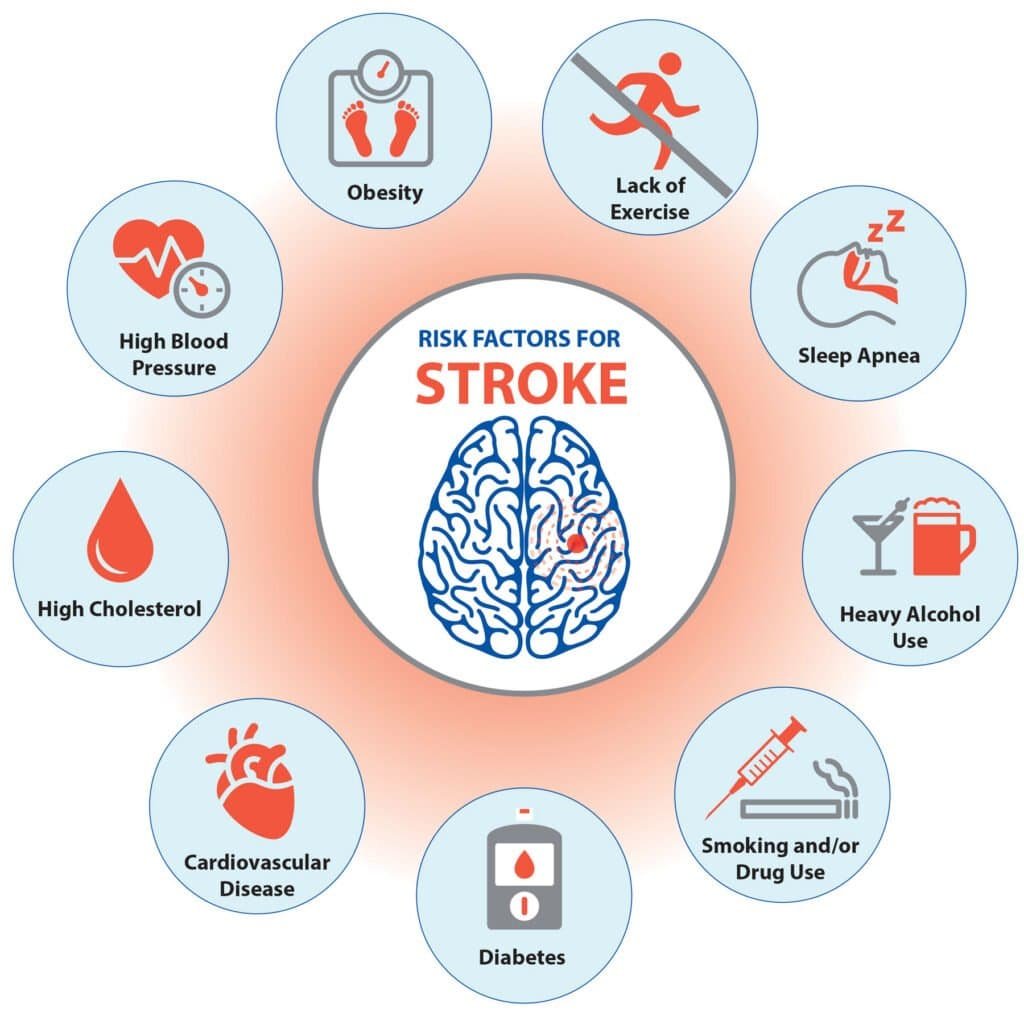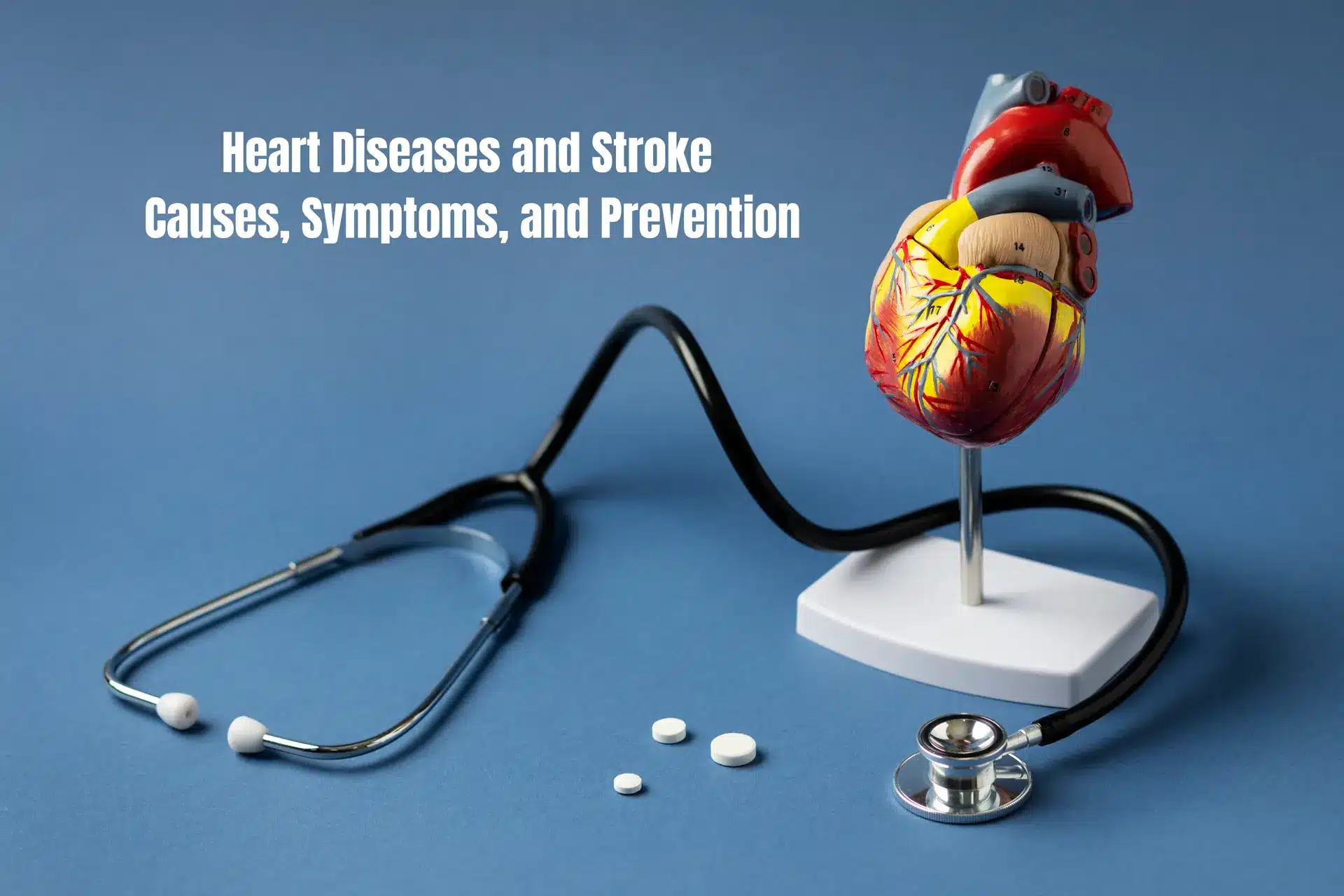Heart diseases and strokes are two of the leading causes of death worldwide, claiming millions of lives each year. These cardiovascular conditions can strike anyone, regardless of age, gender, or background, making it crucial for us to understand their causes, symptoms, and how to prevent them. In this comprehensive article, we will delve into the intricacies of heart diseases and strokes, shedding light on what makes them so dangerous and how we can reduce our risk.
According to the latest WHO data published in 2020 Stroke Deaths in Bangladesh reached 134,166 or 18.74% of total deaths. The age-adjusted Death Rate is 119.20 per 100,000 of population ranks Bangladesh 41 in the world. And for Coronary Heart Disease Deaths in Bangladesh reached 108,528 or 15.16% of total deaths. The age-adjusted Death Rate is 94.27 per 100,000 of population ranks Bangladesh 118 in the world.
Heart Diseases
Heart diseases encompass a wide range of conditions that affect the heart’s structure and function. The most common type is coronary artery disease (CAD), which occurs when the blood vessels that supply the heart muscle become narrowed or blocked due to the buildup of plaque. Other types include heart failure, arrhythmias, and valve diseases.

Causes:
The primary causes of heart diseases are complex and multifactorial. They can be influenced by genetics, lifestyle choices, and underlying medical conditions. Let’s explore these causes in detail:
- Poor Lifestyle Choices: Lifestyle factors play a significant role in the development of heart diseases. Smoking, a high-fat diet, lack of physical activity, and excessive alcohol consumption can increase the risk of heart disease. Smoking, in particular, is a major contributor to atherosclerosis, the process of plaque buildup in the arteries.
- Hypertension: High blood pressure is a common and dangerous risk factor for heart diseases. Over time, high blood pressure can damage the arteries and strain the heart, making it harder to pump blood throughout the body.
- Cholesterol Levels: High levels of LDL (low-density lipoprotein) cholesterol, often referred to as “bad” cholesterol, can contribute to the buildup of plaque in the arteries. On the other hand, HDL (high-density lipoprotein) cholesterol is considered “good” cholesterol because it helps remove LDL cholesterol from the bloodstream.
- Diabetes: Uncontrolled diabetes can harm blood vessels and increase the likelihood of heart disease. High blood sugar levels can lead to inflammation and damage to the arteries, contributing to the development of atherosclerosis.
- Family History: Genetics can play a significant role in heart disease risk. If you have a family history of heart disease, your risk may be higher, even if you lead a healthy lifestyle.
- Age: The risk of heart disease increases with age. As people get older, the risk factors for heart diseases, such as high blood pressure and high cholesterol, tend to become more common.
- Gender: While heart diseases can affect both men and women, there are some gender differences in risk factors and symptoms. Men are more likely to develop heart diseases at an earlier age, but women’s risk increases after menopause.
Symptoms:
Common symptoms of heart disease include chest pain or discomfort, shortness of breath, fatigue, irregular heartbeat, and swollen ankles. However, it’s essential to note that some individuals, especially women, may experience atypical symptoms like nausea, jaw pain, or back pain. These atypical symptoms can make it challenging to recognize a heart problem, which is why it’s crucial to seek medical attention if you experience any unusual or persistent symptoms.
- Chest pain, chest tightness, chest pressure and chest discomfort (angina)
- Shortness of breath
- Pain in the neck, jaw, throat, upper belly area or back
- Pain, numbness, weakness, or coldness in the legs or arms if the blood vessels in those body areas are narrowed
When to see a doctor:
Seek emergency medical care if you have these heart disease symptoms:
- Chest pain
- Shortness of breath
- Fainting
Strokes
Strokes, often referred to as “brain attacks,” occur when there is a disruption in the blood supply to the brain, leading to brain cell damage. Strokes are a medical emergency and require immediate attention. There are two primary types of strokes:
- Ischemic Stroke: This is the most common type of stroke, accounting for about 87% of all cases. It occurs when a blood clot blocks an artery supplying the brain. The clot may form in the brain’s blood vessels or travel from elsewhere in the body, such as the heart or neck arteries, to the brain.
- Hemorrhagic Stroke: This type of stroke results from a weakened blood vessel that ruptures and bleeds into the brain. Hemorrhagic strokes are less common but often more severe than ischemic strokes.
Causes of strokes:
- Hypertension: High blood pressure is the most critical risk factor for strokes. Over time, high blood pressure can damage the delicate blood vessels in the brain, making them more prone to rupture or the formation of blood clots.
- Atrial Fibrillation: Atrial fibrillation is an irregular heartbeat that can lead to blood clots in the heart’s upper chambers (atria). If a clot forms and is pumped out of the heart, it can travel to the brain and cause an ischemic stroke.
- Smoking: Tobacco use doubles the risk of stroke. Smoking not only increases the likelihood of atherosclerosis but also makes blood more prone to clotting.
- Diabetes: Uncontrolled diabetes increases the risk of stroke by damaging blood vessels throughout the body. High blood sugar levels can also contribute to inflammation, which can further worsen the risk of stroke.
- High Cholesterol: Elevated levels of LDL (bad) cholesterol can contribute to atherosclerosis and increase the risk of clot formation, leading to stroke.
Symptoms:
Common symptoms of a stroke include sudden numbness or weakness in the face, arm, or leg, especially on one side of the body, sudden confusion, trouble speaking or understanding speech, sudden severe headache, and difficulty walking or maintaining balance. The key to recognizing a stroke is the acronym FAST:
- Face Drooping: Is one side of the face drooping or numb?
- Arm Weakness: Is one arm weak or numb?
- Speech Difficulty: Is speech slurred, garbled, or hard to understand?
- Time to Call 999: If you observe any of these signs, it’s time to call for emergency medical assistance.
Immediate medical attention is crucial for stroke treatment because certain treatments, such as clot-busting medications or mechanical thrombectomy, can be administered to restore blood flow to the brain if given within a specific time window.
Prevention Strategies
The good news is that many heart diseases and strokes can be prevented through lifestyle changes and proper medical management. Here are some essential prevention strategies:
- Healthy Lifestyle: Adopting a heart-healthy lifestyle is the foundation for preventing heart diseases and strokes. This includes:
- Diet: Consume a diet rich in fruits, vegetables, whole grains, and lean proteins. Limit saturated and trans fats, as well as sodium (salt). Choose unsaturated fats like those found in nuts, seeds, and olive oil. Avoid or limit processed foods, sugary drinks, and excessive caffeine intake.
- Physical Activity: Engage in regular physical activity, aiming for at least 150 minutes of moderate-intensity exercise or 75 minutes of vigorous-intensity exercise per week. Physical activity helps maintain a healthy weight, lowers blood pressure, and improves overall cardiovascular health.
- Smoking Cessation: If you smoke, quitting is one of the most significant steps you can take to reduce your risk of heart diseases and strokes. Smoking cessation programs and support are available to help you quit for good.
- Moderate Alcohol Consumption: If you choose to drink alcohol, do so in moderation. This typically means up to one drink per day for women and up to two drinks per day for men.
- Control Blood Pressure: Regularly monitor your blood pressure and follow your healthcare provider’s recommendations for managing hypertension. This may include medication, dietary changes, and lifestyle modifications.
- Manage Diabetes: If you have diabetes, work closely with your healthcare team to keep your blood sugar levels under control through diet, exercise, and medication as prescribed. Regular blood sugar monitoring is essential.
- Maintain a Healthy Weight: Being overweight or obese increases the risk of heart diseases and strokes. Achieve and maintain a healthy weight through a combination of a balanced diet and regular physical activity.
- Medication Adherence: If you have been prescribed medication for heart conditions or hypertension, take them as directed by your healthcare provider. Medications can help control risk factors and prevent complications.
- Regular Check-ups: Visit your healthcare provider for regular check-ups and screenings to assess your cardiovascular health. These appointments can help identify risk factors early and guide preventive measures.
- Know the Warning Signs: Be aware of the symptoms of heart diseases and strokes, as discussed earlier in this article. Knowing the signs and acting quickly can make a significant difference in the outcome of these conditions.
- Cholesterol Management: Work with your healthcare provider to manage your cholesterol levels. If you have high LDL cholesterol, you may be prescribed statin medications to lower it. Lifestyle changes, such as a heart-healthy diet and regular exercise, can also help manage cholesterol levels.
- Stress Reduction: Chronic stress can contribute to heart diseases and strokes. Find healthy ways to manage stress, such as meditation, yoga, deep breathing exercises, or seeking support from a mental health professional.
- Sleep: Aim for seven to nine hours of quality sleep per night. Poor sleep quality and inadequate sleep duration have been linked to an increased risk of cardiovascular diseases.
Heart diseases and strokes are preventable and manageable conditions when we take the right steps to prioritize our cardiovascular health. By understanding the causes, recognizing the symptoms, and following prevention strategies, we can significantly reduce the risk of these life-threatening conditions and lead healthier, longer lives. Your heart and brain will thank you for it. Remember that your healthcare provider is an essential partner in your journey to heart health, so don’t hesitate to seek their guidance and support.
References:
- WHO- World Life Expectancy-Data analysis: https://www.worldlifeexpectancy.com/bangladesh-coronary-heart-disease
- Mayo Clinic (USA): https://www.mayoclinic.org/diseases-conditions/heart-disease/symptoms-causes/syc-20353118
- National health service(NHA)-UK: https://www.nhs.uk/conditions/stroke/treatment/
- WHO: https://www.emro.who.int/health-topics/stroke-cerebrovascular-accident/index.html?utm_medium=email&utm_source=transaction


